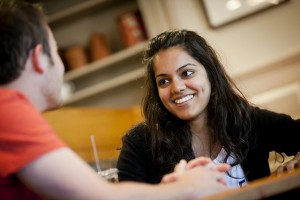
Luis Schettino, assistant professor of psychology, and Camille Borland '13 are researching a computerized, wearable glove that studies human grasping behavior.
By Michele Tallarita ’12
Imagine tens of thousands of neuroscientists coming together from around the world to present research on topics spanning every segment of the discipline, from molecular and physiological work to robotics and prosthetics.
Every year, this is exactly what happens at the Society for Neuroscience annual meeting.
Camille Borland ’13 (Verona, N.J.), Blaine Caslin ’13 (Howell, N.J.), David Lehman ’12 (Knoxville, Md.), Monica Manglani ’13 (Woodbury, N.Y.), and Saye Nessa ’12 (Egg Harbor Township, N.J.) were among the legions of scientists to present research at this year’s conference. Manglani presented on the genes related to reading disability (RD), while Nessa and Borland presented on the organization of fingers during grasping. Caslin and Lehman presented research on the impact of a ketogenic (high-fat, low-protein, and caloric-restricted) diet on a fly model of epilepsy.
The students—all neuroscience majors—reported that the experience was “phenomenal,” “eye-opening,” and “a lot of fun.”
“With about 35,000 people there, from all over the world, it definitely helped me realize how large the field of neuroscience research is and how many people truly care about others’ findings,” Borland says.
“It made neuroscience a lot more exciting than it already is to me,” says Nessa. “It helped solidify my desire to be involved in clinical research in the future. I can’t see myself not doing research at this point.”
Borland and Nessa’s project, which was headed by Luis Schettino, assistant professor of psychology, looked at what fingers do as the human hand comes into contact with an object. In order to conduct this research, the group collaborated with Yih-Choung Yu, associate professor of electrical and computer engineering, to design and produce a glove that permits exact recordings of finger movements.
The group then studied how grasping is affected by different conditions, like the shape of the object being grasped or whether the room is light or dark.
“Perhaps the findings of this research can be used to track progress during motor rehabilitation in stroke patients,” says Nessa.

Monica Manglani ’13
Manglani’s project, headed by Lisa Gabel, assistant professor of psychology, involved getting to the root of RD, a condition that impairs reading accuracy, speed, and/or comprehension despite intelligence and educational background. Specifically, she sought to find the effect of a “conditional knockout” of the gene Dyx1c1 on a variety of cognitive functions, like memory and anxiety. In the end, she demonstrated that the knockout of this gene results in a shallower learning curve in mice moving through a maze.
The research could help suggest the correct therapy for individuals with this specific gene mutation.
“RD affects a large amount of the current population. The sooner an intervention takes place, the better,” she says.
Caslin and Lehman worked on their research with Elaine Reynolds, associate professor of biology, and Stephen Conway ’10. The team raised flies on various diets and evaluated the percentage of flies that experienced seizures and their mean recovery time. According to Lehman, the ketogenic diet is typically used in children with epilepsy who do not respond to drugs. The project studied how and why this treatment is effective.
Lehman will be attending medical school in the fall.
“The experiences I’ve had performing and presenting research with Dr. Reynolds, as well as working as a teaching assistant for neurobiology, have strongly influenced my goal of a career in academic medicine – one that involves significant research as well as seeing patients,” says Lehman.
Manglani spent her summer as an undergraduate researcher at the famed Cold Spring Harbor Laboratory, where she conducted experiments analyzing how the brain recognizes sound. On campus, she serves as a teaching assistant for a neurobiology course, volunteers with Alternative School Break, and is a resident adviser. She also owns the small business Cakes for a Cause.
Nessa volunteers with the Landis Community Outreach Center at the Safe Harbor homeless shelter and continues to do research with Schettino on finger timing. She also participated in Interconnections in Northeast Asia, a study-abroad course in China, South Korea, and North Korea this summer.
A teaching assistant in biology, Borland has shadowed several doctors and plans to attend medical school. Conducting neuroscience research, she says, has given her a leg up on her future career.
“It has given me the opportunity to practice patience and people-skills, which are vital characteristics needed for working in the medical field,” she says.


2 Comments
Lafayette College is simply an outstanding academic institution . The above work in the neuroscience field demonstrates Lafayette College’s phenomenal ability to grow and offer its students a wonderful education. I strongly feel that the field of neuroscience will play a major role in the field of medicine. These students and faculty advisors deserve a tremendous amount of credit and make me prouder to be a graduate of Lafayette College. I am grateful to have had teachers like Dr. Bernard Marklein in chemistry. Keep up the great work. Bob Franco ’75
Comments are closed.